Michigan vegetable crop report - June 30, 2022
Heat related symptoms on plants are evident now, affecting quality of some crops and delaying or stunting growth in others.
Weather
Watch BJ Baule’s weather update here.
The official U.S. Drought Monitor says we are not in a drought, but soil moisture levels are getting drawn down by plants in this heat, and broad regional rain forecasts are light and scattered.
The forecast calls for:
- Clearing today, near normal Wednesday and hot Thursday.
- Near normal/warm Friday into the weekend. Chance of rain decreasing over the weekend.
- Daytime temperatures in the upper 70s far to mid-80s Wednesday, rising to the upper 80s/low 90s Thursday, falling back to the low/mid-80s Friday into the weekend. Lows in the 60s, a bit warmer Friday.
- Potential evapotranspiration, crop water demand continue at above normal rates.
- Medium range guidance calls for near-normal (N) to above normal temperature (S), with precipitation leaning above average.
Help is here: Get plugged into the new Enviroweather
Do you need help with setting up an account and dashboard on Enviroweather’s new website? You can send an email to eweather@msu.edu with the weather stations, crops and models that you are interested in, and we’ll set it up.
Pepper fake
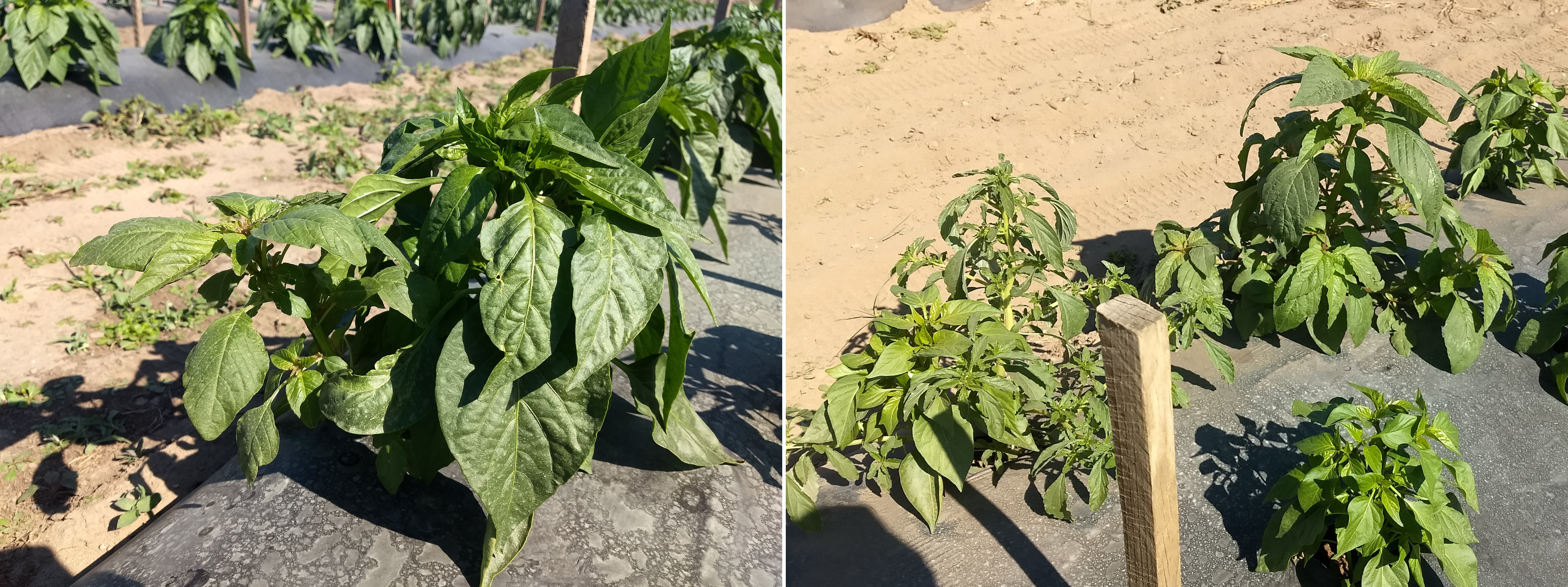
I shared these frustrating pictures with my colleague, James Dedecker, and he had this interesting thought. “It's easy to imagine how such similarities evolved between certain weeds and crops. The more a weed looks like the crop it's in, the less likely it gets removed by people, the more likely it survives to reproduce.”
Crop updates
Asparagus
Yay!!! Harvest wrapped up in west central, with the last pickings late last week, after a year of blockbuster yields. Growers did their best to shut down fields quickly, but it was tough to do given the high heat, and some spears got nipped by herbicide. Pigweed was dead or dying in some fields this Monday, so hopefully burndowns were effective.
At the time of writing this (evening of June 28) there is a hopeful forecast for rain, which would be much welcomed for activation of herbicides and incorporation of fertilizer. Regards herbicides, check out this nice article from Iowa State; it suggests a general rule of thumb is that a 0.5 inch of rain is needed within five to seven days of application. Hopefully we’ll get it!
Crop scouts and MSU Extension are putting out TomCast sensors for timing fungicide applications for purple spot. A first fungicide cover is warranted once fern branches and needles start to expand. Chlorothalonil or mancozeb are helpful for purple spot, tebuconazole helps with rust. Purple spot lesions were visible on stems of younger fields that had been shut down, so this pathogen has been active.
Irrigation has been a main focus in annual veggies this past week. Does it pay to irrigate asparagus fern? Brainard’s lab collected data showing a significant yield response, the year after very droughty conditions in late July/early August. Benefits were greatest for the variety Millennium (compared to Jersey Supreme), and for young plantings. During the period 2012-2017, for example, increases were biggest in 2013 and 2015. Over that length of time, irrigated plots yielded approximately 2,400 lb/ac more (this is cumulative yield over the entire 5 years). Watch a short video describing some of these results.
Carrots and celery
Aster leafhopper infectivity continued to be low in carrots and celery. Infectivity was 0% for an Oceana County sample taken on June 27 and a Newaygo County sample from June 23. It was 1.4% for a Muskegon County sample taken June 23. At an infectivity of 1.4%, the threshold for carrots is 36 leafhoppers per 100 sweeps, and 25 per 100 sweeps for celery.
Crop consultants report modest aster leafhopper numbers in celery so far this week, with some tarnished plant bug also present. Celery leaftier moths are also present, and some variegated cutworm moths were captured in southwest Michigan traps.
Cole crops
Broccoli and kale harvest are underway in southwest Michigan. Broccoli head quality is suffering from the heat waves. If your market supports the smaller “side shoots” that broccoli produces, then it may be worth your time to cut off the low quality main heads to encourage side shoots. They will come along shortly in a rush, and you can harvest those instead. If it’s your first time with broccoli, it can help to look into the spring/summer varieties and summer/fall varieties. Everything has its limits, but the spring-plant/summer-harvest varieties can keep tighter heads better amid the heat.
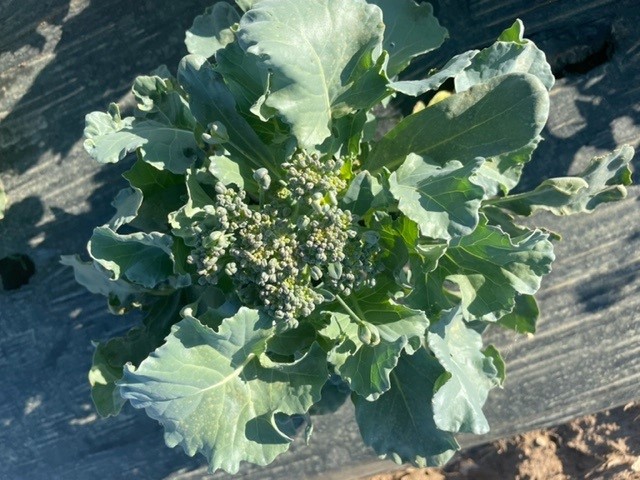
Peak activity of the early summer generation of cabbage maggot flies is expected to begin this week, based on weather at the Allegan, Fennville, Hudsonville, and Grant Enviroweather stations. These flies are the offspring of the maggots that developed around late May. Past experience suggests this generation of flies can do significant damage in turnips. Based on colleagues' experience in Ontario, later sowings of rutabagas are more troubled by the next generation (not this one), as they may just be getting sown or started. Leafy brassicas-with the exception of Napa cabbage-typically do not suffer from this generation (just the spring, or overwintered one). It will be important to protect susceptible root crops from damage when and where possible. Read more in Controlling cabbage maggot in turnips with the Lorsban ban.
Cucurbits/Pickles
Harvest of field-planted fresh market cucumbers, pickles, and summer squash started last week. Volumes are picking up. Quality is mostly good, but cucumber beetle scarring has been severe on cucumber fruit on some farms.
The striped cucumber beetle population has been reported as “very high” this year by a number of growers. I have not yet seen the spotted ones, which migrate up from the south. In addition to fruit scarring, cucumber beetles can also transfer two different diseases that impact marketable yield: bacterial wilt and Squash Mosaic Virus (SqMV). Bacterial wilt can cause rapid decline and death of any cucurbit, but SqMV tends to be more of a problem in summer squash because of the lumpy-shaped fruits that are its diagnostic symptom. In either case, the solution is preventative management of the beetles.
The beginning of July has marked the onset of downy mildew on cucumber in Michigan. At this time, downy mildew infection has not been detected on cucumber. Downy mildew disease has been found in the eastern U.S. as far north as New Jersey. In Michigan, aerial downy mildew spores have been detected in Bay, Saginaw, and Berrien counties this year. It is especially important to intensively scout for downy mildew symptoms (tipsheet here) and to use proven protectant fungicides (found here) before symptoms begin.
Phytophthora fruit rot on pickles continues to be a major threat for some Michigan growers. Effective fungicides must be applied so that they cover the fruit. Fungicides applied to the soil are not effective and do not limit the pathogen. Also, fungicides applied to the foliage are not translocated to the fruit. Banded applications of fungicides can be used to protect young plants. Fungicides applied with high amounts of water (30 gallons) are more likely to penetrate the plant canopy and reach the fruit underneath. Previous MSU research to determine the timing of fungicide applications showed that fungicides must be applied when the fruit are 1”, 3” and 5” in length. The days between these fruit growth stages can vary based on the weather. Although Phytophthora and downy mildew are both oomycete pathogens, the products used for their management vary.
Here are tipsheets for these oomycete pathogens, comparing and contrasting effective fungicidal options.
- Cucurbit Downy Mildew: Managing Cucurbit Downy Mildew
- Phytophthora: Managing Phytophthora on Cucumber
- Phytophthora: Managing Phytophthora on Summer Squash and Zucchini
- Phytophthora: Managing Phytophthora on Winter Squash and Pumpkin
- Phytophthora: Managing Phytophthora on Cantaloupe, Muskmelon and Watermelon
Greens/Herbs
Several types of greens and herbs from several crop families are being harvested continually now, and also successionally planted. But the heat is a challenge on both ends. Overhead watering plants close to harvest to keep their leaves full of water, and starting the cold chain with rapid cooling after harvest is key to maximize shelf life. Stronger flavors are more prominent without well-watered plants. In the case of lettuces, that means bitter, and mustard greens burn the nose more. On the planting side, it is key to keep moisture at the soil surface to aid rooting during the heat.
Onions/Garlic
Garlic tops are yellowing with maturity and starting to size up their bulbs.
Some farms had already made two Movento applications, while others were making their second this week. Movento must be tank mixed with a penetrating surfactant to maximize leaf uptake and systemic activity. The minimum interval between applications is seven days, the application rate is 5 fl oz/ acre with 10 fl oz/acre maximum allowed per season. You can apply the second Movento application more than seven days after the first application according to the label but it is possible that by holding off longer, you delay so far into the season that the second application will not be effective due to the high thrips pressure. The second application within seven to 10 days is also necessary to have good control of thrips, indicating that the two applications together deliver sufficient systemic activity to suppress populations.
Already done with Movento? You can decide on what to use (or not use) in the post Movento slots based on thrips numbers. If populations are <0.6-1 per leaf, you can skip a week. If they are low low (between 0.6-1 per leaf) you could use Agri-Mek. If they are moderate, you could use Minecto Pro. If they are high, you could use Radiant. Check out Cornell's thrips control guidelines for 2022.
Stemphylium leaf blight causes premature leaf death leading to reduced bulb size and lower total yield. Field research from Michigan State University testing two fungicide programs applied at 7-day application intervals (Table 1) showed that both programs were equally effective at reducing Stemphylium leaf blight symptoms. Further, fungicide programs were most effective at limiting disease when initiated no later than the 5-7 leaf stage, but a consistent increase in yield over the two-year study was only achieved when fungicides were applied starting at the 3-4 leaf stage.
Table 1. Two fungicide programs applied at 7-day intervals for Stemphylium leaf blight control by Michigan State University in field trials.
|
Program 1 |
Program 2 |
||||
|
Product |
FRAC |
Timing |
Product |
FRAC |
Timing |
|
Luna Tranquility |
7/9 |
adj |
Bravo WS |
M05 |
adghj |
|
Tilt SC + Bravo WS |
3/M05 |
be |
Tilt SC |
3 |
be |
|
Omega 500 F |
29 |
cg |
Luna Tranquility |
7/9 |
ci |
|
Miravis Prime |
7/12 |
fi |
Miravis Prime |
7/12 |
f |
|
Aprovia Top |
7 |
h |
|
|
|
The Stemphylium leaf blight pathogen is considered high risk to develop resistance to some of the active ingredients in commonly used fungicide products. It is essential to rotate among fungicides with different FRAC codes. Also, avoid letting disease pressure build to high levels as this will expose a greater portion of the pathogen population to the fungicides and increase the likelihood for resistance to develop. The table below (Table 2) can be used as guide for producers putting together their programs.
Table 2. Fungicides labeled for use on onion included in MSU field studies
|
Product |
Active ingredient |
FRAC |
Number of applications allowed by the label |
|
Rovral 4 |
iprodione |
2 |
5 |
|
Tilt |
propiconazole |
3 |
2 to 4 (solo); 4 to 8 (in tank mixes) |
|
Luna Experience |
tebuconazole/fluopyram |
3/7 |
2 |
|
Aprovia Top |
difenoconazole/benzovindiflupyr |
3/7 |
4 |
|
Luna Tranquility |
fluopyram/pyrimethanil |
7/9 |
2 to 3 |
|
Merivon |
fluxapyroxad/pyraclostrobin |
7/11 |
3 to 6 |
|
Miravis Prime |
pydiflumetofen/fludioxonil |
7/12 |
3 |
|
Omega SC |
fluazinam |
29 |
3 to 6 |
|
Bravo WS |
chlorothalonil |
M05 |
6 |
|
Manzate PS |
Mancozeb |
M03 |
10 |
*The FRAC code is an alphanumeric code assigned by the Fungicide Resistance Action Committee and is based on the mode of action of the active ingredient.
** The number of applications allowed by the label may vary depending on the rate applied. Remember that the pesticide label is the legal document on pesticide use. Read the label and follow all instructions closely.
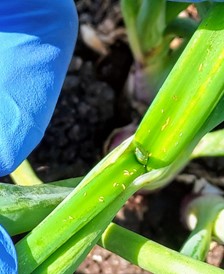
Please do not save “the good stuff” for later! It is understandable to worry about running out of fungicides for Stemphylium, especially given the smaller size of onions that went in late. However, delaying too long means they will be less effective. Hausbeck’s work showed that fungicide programs to protect the onion’s foliage from Stemphylium leaf blight should begin when plant are young (by the 5- to 7-leaf stage) and include highly effective products at the front end of the season to prevent the pathogen from becoming too well established. Protecting the onion leaves early in the season helps to ensure that the plants have a fighting chance to reach maturity and achieve their full yield potential.
Peas/Beans
Leaf scorch was reported last week in green beans. The youngest top-most leaves of the plant curl upwards and dry up. This is a response to prolonged high sunlight and temperatures, and can be worse after a rain or in fields with excess nitrogen left over from a previous crop, or multi-nutrient fertilizer applications like green manures, manures, or composts. Remember, beans make their own nitrogen, and don’t need more. The succulent young leaves are not able to withstand such strong light. It is not a disease caused by a pathogen.
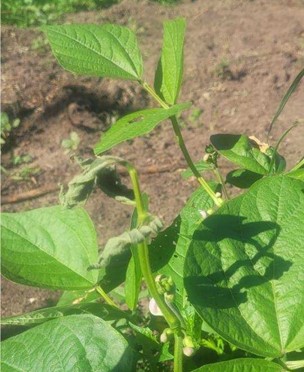
Potato
Early protectant fungicides are going on as the canopy is closing in-row spaces and TOMCAST models also support this decision. There was some stunting from high heat at first emergence, similar to the bean scorch reported above. The first leaves in some plantings emerged during the heat waves and were too tender to handle the bright light and heat. Secondary shoots are now beginning to break the surface.
Colorado potato beetles are currently pupating in many areas of Michigan, indicating that in 1-2 weeks we will see summer adults emerging. This observation aligns with the developmental model available for Colorado potato beetles indicating that 675 accumulated degree days (base 52F) are needed to reach the pupal stage. We are currently at 700 in the East Lansing area. The emergence of the summer generation of adults marks the time when insecticide programs should switch classes of active ingredients. The table below lists insecticides recommended for the summer generation especially if neonicotinoids were used earlier in the season. For resistance management purposes using the same active ingredient (IRAC) is recommended for the summer generation. Scouting for CPB is an important part of correctly timing foliar insecticide applications and thus preventing insecticide resistance becoming a major problem. Scouts visually survey multiple whole plants per field to count egg masses, small / large larvae and adults. They record these numbers to determine if an economic threshold has been reached. The typical threshold used is 1 large larva per plant or 1 adult per plant in a field.
|
Products for summer Colorado potato beetle management |
|||
|
Delivery |
Insecticide name |
Active Ingredient |
IRAC |
|
Foliar |
Agri-Mek, generics |
abamectin |
6 |
|
Foliar |
Coragen, Voliam Xpress1 |
chlorantraniliprole |
28 |
|
Foliar |
Exirel |
cyantraniliprole |
28 |
|
Foliar |
Admire Pro, generics |
imidacloprid |
4A |
|
Foliar |
Avaunt2 |
indoxacarb |
22A |
|
Foliar |
Torac |
tolfenpyrad |
21A |
|
Foliar |
Radiant |
spinetoram |
5 |
|
Foliar |
Blackhawk, Entrust |
spinosad |
5 |
|
1 Mixed with pyrethroid, apply when potato leafhoppers are also problematic 2 Avaunt has limited activity on larvae |
|||
Fruiting vegetables
Field peppers and tomatoes are just starting to set fruit and size them up. Main harvest is still about a month away, but some growers are on the cusp of early harvest of protected spring plantings. Blossom-end rot (BER) has been reported. BER is the plant telling you that it needs more regular soil moisture access to push calcium all the way to the ends of the fruit. You most likely have adequate calcium levels in the soil. It’s the moisture consistency that’s the issue, and fruit loads pull a mighty draw, especially in the heat. This is typically an issue on the first set of fruit, and Romas and San Marzanos get it worse than beefsteaks. I rarely see it in grape and cherry tomatoes. It doesn’t seem to matter if it’s an early or late planting, indoor or outdoor. Some combination of plants self-correcting by moderating their fruit loads, or you recognizing the symptoms and watering, tends to level out the problem with future fruit.
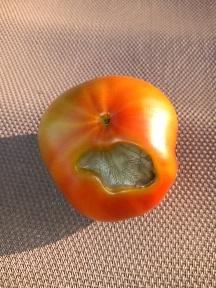
TOM-CAST model for Alternaria early blight have reached their first threshold, or will be soon, across much of the state. When the threshold is reached, an application of chlorothalonil (Bravo) and azoxystrobin (Quadris) is warranted to protect plants and fruit. Bacterial diseases are not predicted by this model and should be handled differently.
Last week we discussed wilted pepper plants, with dark stem lesions that were caused by Phytophthora. More recently tomato plants of similar size were submitted to the MSU Plant and Pest Diagnostic Lab. The tomato plants had similar stem lesions but in this case the stem lesions were caused by Pythium, not Phytophthora. Without lab testing/culturing symptoms caused by these two pathogens are indistinguishable.
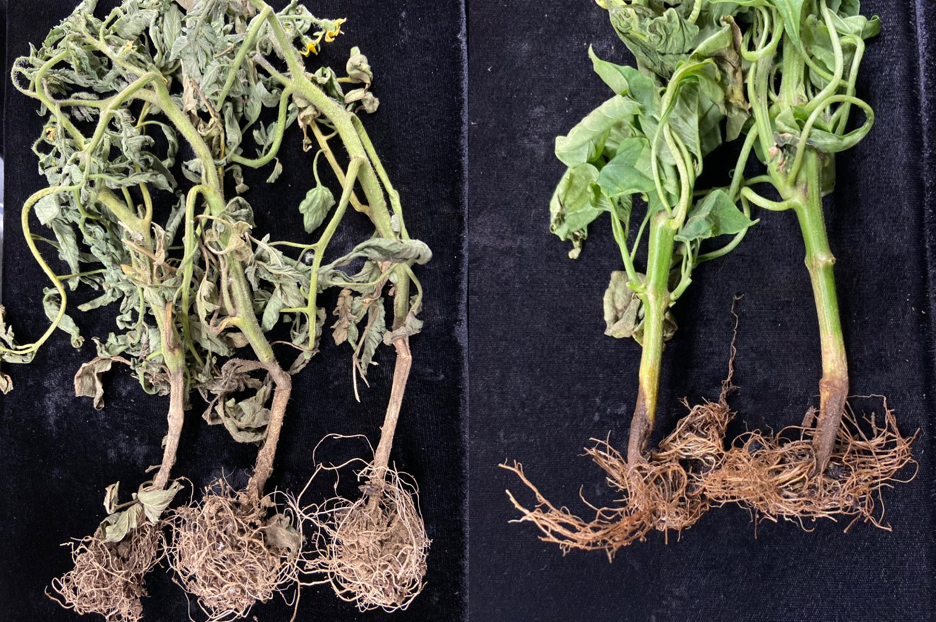
Here is another tip sheet for this oomycete pathogen, including effective fungicidal options: Managing Phytophthora on Pepper
Colorado potato beetle larvae are feeding on eggplants and beginning to pupate into the next generation. This should trigger a change-up in your insecticide choices. See Potato section above.
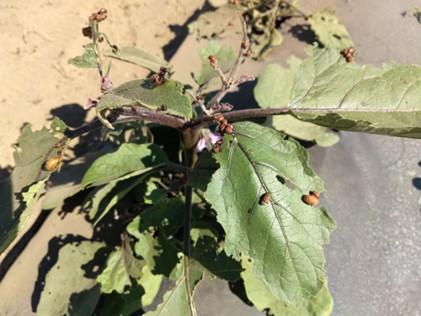
Root crops
Carrots and red beets were being pulled this week for the first time on some farms.
Strawberries
Strawberry harvest continues in some locations, but is finishing in most areas. Fruit rots are being seen. Maintain fungicide coverage to protect the leaves and help prevent fruit rots as fruit continues to ripen, especially with the heat. The heat, humidity and rain have shortened the season for some growers. Those who are done with harvest are beginning to renovate.
Sweet Corn
Early sweet corn is tasseling. I have not caught any European corn borers in traps yet, and none have been reported from other trap collaborators. But, I caught one western bean cutworm and three corn earworms.
Events
- July 13: Hops Field Day from 10 a.m. to 2 p.m. at the on-campus Plant Pathology Field Laboratory at 3735 N. College Road in Lansing. The event features presentations on disease management, viruses, nematodes, insects and tips on brewing.
- July 19: Dairy Open House from 4:30 to 8:30 p.m. at the K. Kellogg Biological Station. The station is located at 3700 East Gull Lake Drive in Hickory Corners. Attendees can sample MSU ice cream, while participating in family friendly activities. Guests can also participate in a guided tour of the barn and learn about Michigan's agricultural landscapes. For more information, contact the station via email at pasture.dairy@kbs.msu.edu or call 269-671-2402.
- July 27: Viticulture Field Day at the Southwest Michigan Research and Extension Center. The center is located at 1791 Hillandale Road in Benton Harbor.
- Aug. 4: Potato Field Day from 8 a.m. to 3 p.m. at the Montcalm Research Center. The center is located at 4629 W. McBride Road in Lakeview. Presentation topics include sustainability, irrigation and potato storage management.
- Aug. 10: Turf Field Day at the on-campus Hancock Turfgrass Research Center. The center is located at 4444 Farm Lane in Lansing.
- Aug. 11: Field Day and Pasture Walk at the Lake City Research Center. The center is located at 5401 W. Jennings Road in Lake City and works primarily in livestock management.
- Aug. 23: Plant Diagnostic Day at the Saginaw Valley Research and Extension Center. The center is located at 3775 S. Reese Road in Frankenmuth.
- Aug. 24: Blueberry field day at the Trevor Nichols Research Center. The center is located at 6237 124th Ave. in Fennville, Michigan.
- Aug. 25: 2022 Tile Drainage Field Day at 13000 Bird Lake Rd, Camden, MI.
- Sept. 8: Field Day at the Northwest Michigan Horticulture Research Center. The center is located at 6686 S. Center Highway in Traverse City and will highlight Michigan fruit advancements.
- Sept. 14: Mechanical Weed Control Field Day at the Southwest Michigan Research and Extension Center. The center is located at 1791 Hillandale Road in Benton Harbor. See https://thelandconnection.org/event/2022-mmwcfd/
This work is supported by the Crop Protection and Pest Management Program [grant no 2021-70006-35450] from the USDA National Institute of Food and Agriculture.



 Print
Print Email
Email

